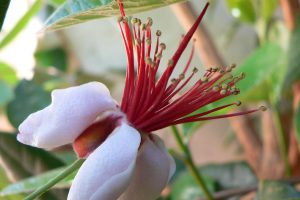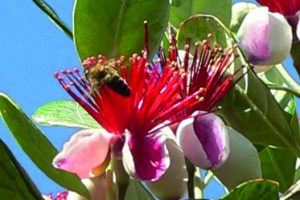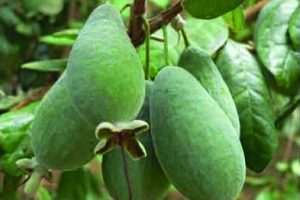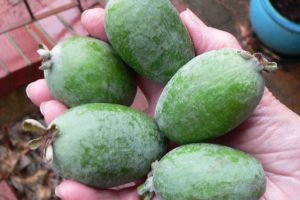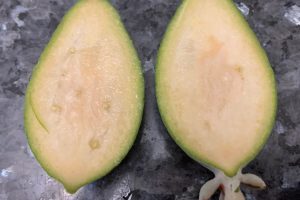Acca (Feijoa) sellowiana
Feijoa, pineapple guava
Origin
It is native to extreme southern Brazil, northern Argentina, western Paraguay and Uruguay, and is common in mountainous regions.
Climate
Sub-tropical, with low humidity and optimum rainfall of 700 – 1000mm. It prefers locations with a cool spell for part of the year and can survive some sub-zero temperatures. It is drought-resistant but needs adequate water for fruit production. Partial shade and slight exposure to salt spray is tolerated.
Cultivars
There are many cultivars – Mammoth, Apollo, Triumph, David, Large Oval, and Chapman are just some of them. Many plants sold by Nurseries are of unknown heritage and often seedlings.
Flowering and Pollination
The axillary hermaphrodite flowers, commonly uniflorate but sometimes in clusters of 2-3, are 3-4cm in diameter, have a green calyx and 4-6 white exterior/mauve interior elliptic spoon-shaped petals and 60-100 bright red stamens with white-tipped anthers. The single central style extends 4-15mm above the plane of the anthers. There is no nectary, but the pollen contains sugars in addition to proteins as a reward for pollinators. Each of the 4-locules in the epigynous ovary contains 30-60 ovules. Flowering may continue for 4-6 weeks and individual flowers only last 1-2 days. The gynoecium is receptive about 24 hours before pollen release (protogynous), and depending on variety and environmental conditions there may be sufficient overlap to allow pollination. Varieties exhibit facultative xenogamy. Self-incompatibility manifests genetically about 30 days after fertilisation, meaning it’s desirable to have more than one plant or multiple grafted varieties. Pollination is by birds feeding on the sweet petals; insects and wind are also thought to contribute. Hand-pollination may be necessary if these vectors are insufficient.
Cultivation
Plants need little care once established, other than pruning to restrict lanky growth. Feijoa has a shallow, fibrous root system which should be left undisturbed. If growing feijoas for their fruit, do not add fertilisers too high in N. They need plentiful water during fruiting.
Wind Tolerance
Good. Well-clipped hedges are often used as windbreaks around orchards.
Pruning
The plant has a tendency to become very leggy and fruit is borne on new growth. These two factors indicate that pruning should begin early with young plants to encourage them to become bushy with lots of fruiting tips. Prune the fruiting branches back as soon as fruit is harvested to allow time for new shoots to grow for the next harvest. Cropping is still good when kept as a hedge
The Fruit
The fruit is a berry and can take many shapes, from round to oblong or pear-shaped. Skin is thin and green, can be blushed with purple or red, and can be smooth or slightly ridged and warty. There are persistent calyx segments adhering to the apex. The flesh, 60-70% of the whole fruit, is white to creamy yellow, with a slightly granular texture, with many very small seeds. The flavour is sweet or subacid and fruity with about 10% soluble sugars. The whole fruit emits a pleasant perfume as it nears maturity.
Fruit Production and Harvesting
It is best to allow the fruits to fall to the ground when they are ready; the flavour will be better than fruit picked prematurely. Keep the ground below the plant clear of thick weeds. A padding layer of clean, dry leaves or straw will help to avoid any bruising. It is best to store the fruits in a cool place as their shelf life in a warm place is only a few days.
Fruit Uses
Usually eaten fresh and scooped out with a spoon. They can be made into a wide range of desserts, jams, ice creams and drinks, and also can be dried.
Pests and Diseases
Fruit fly, otherwise few insect pests. Birds.
Comments
Feijoa is a very tough and hardy plant, attractive and fruitful, but will need annual pruning. It is very ornamental, with showy red and white flowers.
More Information
Periodically members ask about poor fruiting behaviour with feijoa. This species is protogynous & mostly self-incompatible to encourage crosspollination. Although some varieties have partial self-fertility sufficient to set an acceptable crop, it’s usually best to have multiple plants of different genetic diversity, or use grafts. Additionally with our most common pollinator the honeybee, flower attractiveness has to rely on pollen as they don’t produce nectar, & bees are too small for much pollen to dust off on the central stigma as it’s 1-2cm above the anthers. Larger insects or birds have to do the job, or you hand-pollinate.
